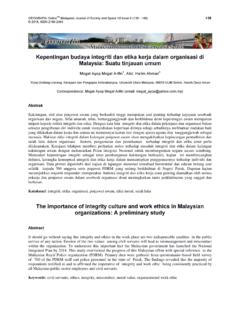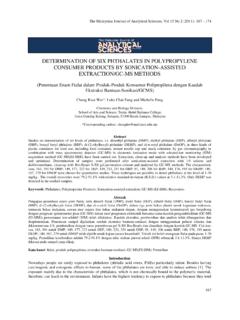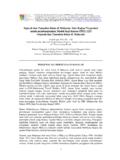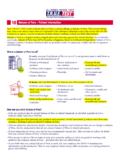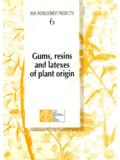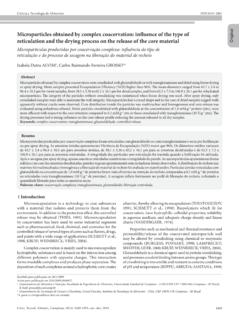Transcription of STABILITY OF CURCUMIN IN TURMERIC OLEORESIN …
1 The Malaysian Journal of Analytical Sciences, Vol 13 No. 2 (2009): 165 - 169. STABILITY OF CURCUMIN IN TURMERIC OLEORESIN - - CYCLODEXTRIN INCLUSION COMPLEX DURING STORAGE. (KESTABILAN KURKUMIN DI DALAM KOMPLEKS RANGKUMAN OLEORESIN - - SIKLODEKSTRIN SEMASA PENYIMPANAN). Zaibunnisa, *, Norashikin, , Mamot, and Osman, 1. Faculty of Applied Sciences, Universiti Teknologi MARA. 40450 Shah Alam, Selangor, Malaysia. 2. Faculty of Science and Technology, Universiti Kebangsaan Malaysia 43600 Bangi, Selangor, Malaysia. *Corresponding author: Abstract To improve the STABILITY of CURCUMIN in TURMERIC rhizome (Curcuma domestica) OLEORESIN during storage, complexation with - cyclodextrin was studied. Pressurised liquid extraction (PLE) is a fast method to extract high quality TURMERIC rhizome OLEORESIN .
2 Extraction conditions was optimised based on maximum major volatile compounds (1,8-cineol, tumerone + ar-tumerone, - zingeberene, -zingeberene and -phellandrene). TURMERIC OLEORESIN exhibit sensitivity to light, heat, oxygen and have short storage lives. Therefore, OLEORESIN obtained was encapsulated with -cyclodextrin (BCD) using kneading method. The STABILITY of CURCUMIN in inclusion complex was monitored for 64 days with exposure to heat and light. The shelf-life of the product was estimated based on half life t1/2 (day) and activation energy, E (kJ/mol). Shelf life of TURMERIC OLEORESIN inclusion complex, stored at 5oC in dark containers can be extended to 154 days. Keywords: CURCUMIN , light, storage, kinetic study, half life and activation energy.
3 Abstrak Untuk memperbaiki kestabilan kurkumin di dalam OLEORESIN kunyit (Curcuma domestica) semasa penyimpanan, kompleks rangkuman dengan -siklodekstrin dikaji. Pengekstrakkan cecair bertekanan tinggi (PLE) dapat menghasilkan OLEORESIN kunyit yang bermutu tinggi. Parameter pengekstrakkan dioptimumkan berdasarkan maksimum bahan meruap utama (1,8-sineol, tumerona + ar-tumerona, -zingeberena, -zingeberena and -felandrena). OLEORESIN kunyit sensitif dengan perubahan cahaya, suhu, oksigen dan menpunyai jangka hayat yang pendek. Oleh kerana itu, OLEORESIN kunyit yang di ekstrak menggunakan PLE, dirangkumkan dengan -siklodekstrin dengan mengunakkan teknik pengulian. Jangka hayat produk diramal dengan menghitungkan tenaga pengaktifan, E (kJ/mol) dan separuh hayat, t1/2 (hari).
4 Jangka hayat kompleks rangkuman OLEORESIN kunyit dapat diperpanjangkan ke 154 hari, jika di simpan pada suhu 5oC didalam keadaan bertutup dan gelap. Kata kunci: kurkumin, simpanan, kajian kinetik, jangka separa hayat dan tenaga pengaktifan Introduction CURCUMIN [1,7-bis (4-hydroxy-3-methoxyphenyl)-1,6-heptadie ne-3,5-dione] is a natural yellow-orange natural dye in TURMERIC rhizome [1]. It is a fat soluble pigment but insoluble in aqueous medium. CURCUMIN is sensitive to light but is moderately stable to heat [2]. Microencapsulation protects OLEORESIN against destructive changes, converts it into a free-flowing powder, delivering more flavour impact in finished products, separate reactive materials from one another, alter surface properties of the materials, control the release of materials, reduce volatility or flammability of liquids, and to mask the bitter taste of certain compounds [3].
5 Attempts to prepare water-soluble CURCUMIN by complex formation or interaction with various macromolecules ( gelatine, polysaccharides) have been reported [4]. Cyclodextrin can bind to various kinds of low molecule compounds into its cave structure, thereby stabilising the low molecule organic compounds by the inclusion effect. CURCUMIN and TURMERIC OLEORESIN had been encapsulated with -cyclodextrin using suspension and co-crystalisation technique by Szente [5]. He reported that -cyclodextrin complexation provided shelf life improvement for CURCUMIN and TURMERIC OLEORESIN (Soxhlet-extraction using n-hexane). However, limited information is available concerning CURCUMIN STABILITY in microencapsulated TURMERIC OLEORESIN .
6 There exists a need to investigate the storage STABILITY of this CURCUMIN in 165. Zaibunnisa et al: STABILITY OF CURCUMIN IN TURMERIC OLEORESIN - -CYCLODEXTRIN. INCLUSION COMPLEX DURING STORAGE. inclusion complex that contributes to unique yellow colour of TURMERIC OLEORESIN . The results will be useful in the application of this inclusion complex in food system. Materials and Methods Sample Preparation Fresh TURMERIC rhizome was obtained from local supplier in Banting, Selangor. The sample were washed under running tap water, sliced (3mm thickness) and air-dried until the moisture content reached Samples were stored in sealed plastic bags at room temperature until needed for analysis. Prior to extraction, samples were further chopped to 3 mm diameter.
7 Pressurised Liquid Extraction (PLE). Extractions were done using ASE 200 accelerated solvent extractor (Dionex Ltd. Camberly, Surrey, UK). OLEORESIN was extracted using n-hexane with predetermined optimised conditions (Design Expert , Stat Ease Software): temperature of 130oC, pressure of 11308 kPa and static time of 16 minutes. The extract was evaporated to dryness using rotary evaporator. Preparation of Inclusion Complex Inclusion complex was prepared following the method used by Zhang [6]. Storage Study Inclusion complex ( g) in clear screw capped vials were placed at three different places; chiller at 5oC (Frost DOR, USA), closed incubator at 33oC (Thermo Scientific Thermolyne Oven Incubator 142300, USA) and oven at 45oC (Memmert, Germany).
8 Half of the samples were covered with aluminium foil as control, whereas the other half was exposed to bright light, 2800-3000 lux, Philips energy saving cool daylight bulbs (5 W). The intensity of the light was measured using EKO Multimeter, Japan. CURCUMIN CURCUMIN was determined following ASTA method [7]. Results and discussion Arrhenius' law was empirically derived to describe the temperature dependence of simple chemical reactions. The key parameter of this equation to estimate shelf-life at different temperature is the activation energy. Usually the reaction rate is determined at three or more temperatures and the logarithms of these values are regressed versus 1/temperature to obtain the activation energy from the resulting slope.
9 For irreversible first order reaction kinetics, the rate constant at constant temperature can be determined through fraction conversion, f: f = (Co C ) / (Co -C ) [1]. where C , the measured non-zero equilibrium CURCUMIN value at infinite time, Co, the measured CURCUMIN value at zero time and C, CURCUMIN value at time t. First order reaction in terms of the fraction conversion may be presented as ln (1-f) = or ln [(C C ) / (Co -C )] = - [2]. Dependence of the degradation rate constant on temperature is represented by the Arrhenius equation: k = ko exp (-E/RT) [3]. where ko, frequency factor (min-1); E, activation energy (kJ/ml); R= universal gas constant ( J/mol K) and T=. absolute temperature (K).
10 A plot of ln (1-f) against t, give k value from the slope (Figure 1). The rate of CURCUMIN degradation in inclusion complex was determined by linear regression; and the coefficients are reported in Table 1. The r2 values showed 166. The Malaysian Journal of Analytical Sciences, Vol 13 No. 2 (2009): 165 - 169. strong correlation except for 33oC/dark and 5oC/dark; and standard errors were less than for the entire range. A plot of ln k against 1/T able to give (-E/R) from the slope (Figure 2). Since R value is known, E value can be calculated. The activation energy can be seen as the energy barrier that molecules need to cross in order to be able to react [8]. Activation energy in the presence of light was kJ/mol and in the dark was kJ/mol.



